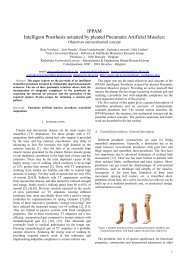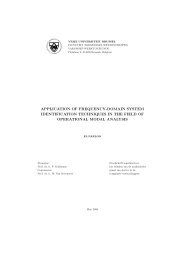VRIJE UNIVERSITEIT BRUSSEL Acoustics - the Dept. of ...
VRIJE UNIVERSITEIT BRUSSEL Acoustics - the Dept. of ...
VRIJE UNIVERSITEIT BRUSSEL Acoustics - the Dept. of ...
Create successful ePaper yourself
Turn your PDF publications into a flip-book with our unique Google optimized e-Paper software.
3.7. BACKGROUND NOISE 45Figure 3.11: Calibration sheet accompanying a microphone. Source:Bruël&Kjær.3.7 Background noiseWhen measuring sound caused by a certain source, all o<strong>the</strong>r sounds presentare considered as background noise. If <strong>the</strong> level <strong>of</strong> <strong>the</strong> background noiseis more than 10 dB lower than <strong>the</strong> total sound pressure level, it can beneglected. If it is less than 10dB lower, a correction is necessary. Assume wewant to determine <strong>the</strong> sound level L S <strong>of</strong> a source, situated in an environmentwith a background sound level L N . The combined sound level (background+ source) is L C . L N and L C are measured and L S is <strong>the</strong> value we want todetermine. Since <strong>the</strong> source and <strong>the</strong> background noise are not correlated, <strong>the</strong>averagequadraticsoundpressures<strong>of</strong><strong>the</strong>combinedsoundand<strong>the</strong>backgroundnoise need to be subtracted to obtain <strong>the</strong> source term. Taking into account<strong>the</strong> definition <strong>of</strong> <strong>the</strong> sound pressure level we find:( )L S = L C +10log 1−10 −L C −L B10(3.1)
















